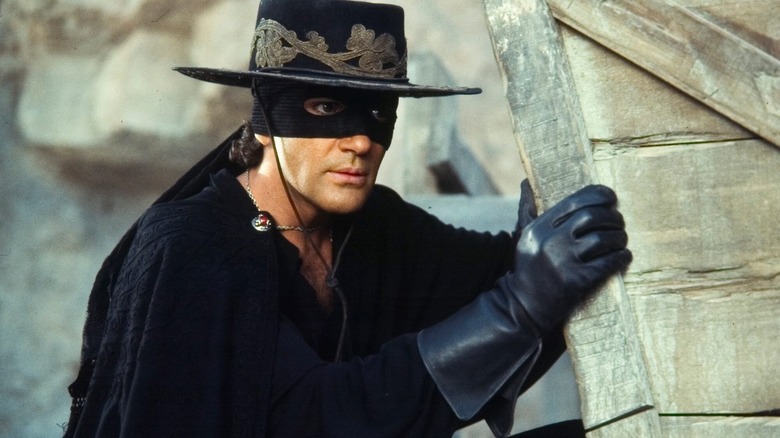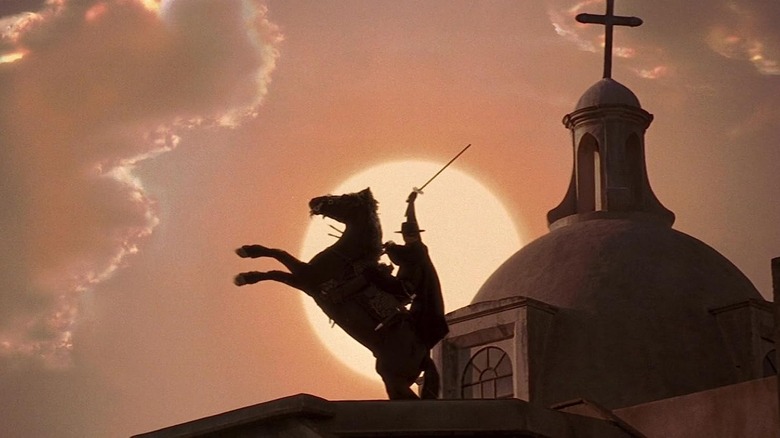Steven Spielberg Predicted Mask Of Zorro Would Be One Of The Last Practical Westerns
"The Mask of Zorro" is now 25 years old, though you might not know by watching it. Director Martin Campbell's 1998 film is a sexy, high-octane swashbuckler that, along with filmmaker Stephen Sommers' remake of "The Mummy," was likely responsible for the bisexual awakening of an entire generation in the late '90s. Leads Antonio Banderas and Catherine Zeta-Jones certainly light up the screen as newbie Zorro-in-training, Alejandro, and his predecessor's daughter, Elena, whether they're cutting a rug across the dance floor or mixing swordplay with flirtation. Then there's the breathtaking practical stunts and set pieces, which Campbell stages with the utmost elegance in collaboration with his cast and crew — not least of all his longtime director of photography Phil Méheux, who imbues the film with a visual grandiosity befitting of a Western epic.
More than anything, it's the film's practical approach that keeps it feeling timeless. Campbell, who had to be wooed by executive producer Steven Spielberg into directing "The Mask of Zorro," knew what he getting himself into, taking on an expensive action-adventure full of horse riding, sword duels, and exploding gold mines with little to no computer generated imagery (CGI). He was ultimately rewarded for his efforts, too. Critics sang the praises of the film's craft, with Roger Ebert writing in his review, "The movie celebrates the kind of Western location shooting that's rarely seen these days." In the end, "The Mask of Zorro" grossed $250 million against its $95 million budget, allowing it to crack that year's top 15 at the global box office.
If there's a blemish on the film's legacy (other than the problematic casting of its three non-Latino leads), it's that it wound up marking the end of an era for practical Westerns — something Spielberg actually predicted during production.
'But things are going to change'
When Steven Spielberg talks about the future of the film industry, you would do well to listen. Much like he foresaw a lot of our current day predicaments concerning movie theaters in 2013, Spielberg knew "The Mask of Zorro" was one of the last of its kind during filming. In an interview with Yahoo! Entertainment to mark the film's 25 year anniversary, Banderas recalled:
"Steven Spielberg said to me once when we were shooting, 'This is probably going to be one of the last Westerns shot in the way the Westerns were shot in the old days, with real scenes with real horses, where everything is real, [real] sword fighting, no CGI.' Everything was [practical]."
"And he said, 'But things are going to change. They're going to change and they're gonna change fast. And so you should be proud of this movie,'" Banderas added. "And I am, probably even more now than at the time that I was doing it." Of course, acclaimed films like the "3:10 to Yuma" and "True Grit" remakes would keep the practical-heavy approach to Westerns alive over the decade that followed, yet they were noticeably lower budgeted affairs than "The Mask of Zorro." Then came the costly misfires that were "Cowboys & Aliens" and Disney's "The Lone Ranger," which tried to remain faithful to the practical tradition while at the same time using CGI to enhance their set pieces and realize their more fantastical elements.
If anything, the practical Western's decline makes it all the easier to appreciate "The Mask of Zorro" looking back. "It was a very beautiful adventure movie with a lot of ingredients that made it shine in a very beautiful way. I have nothing but good memories," said Banderas. So do we.

